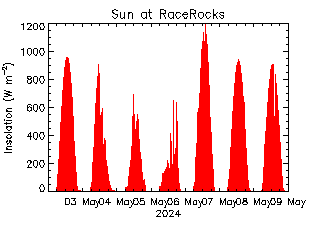| CORRELATIONS FILE: This file is set up with regular additions that have been selected to show seasonal patterns and to allow some study of the relationships between the three factors of solar radiation, uv radiation and temperature | |||
 |
 |
Second exercise on Solar and UV. This one also links through to the raw data references for the factors. |
 |
The SOLAR ENERGY part of the Integrated Energy Project at Race Rocks |
 |
Alternate Energy: Solar, A curriculum resource |
 |
 |
 |
|
Graph of today’s Solar Insolation:
The intensity of the incoming radiation is measured in Watts per square metre (Wm-2)This is the peak solar radiation measured during the archive interval..(30 mins) |
Cick on the above graph for a larger version of the past week’s solar level at Race Rocks. | The “three graphs above represent historical records of Solar insolation at different time scales These graphical interpretations are made possible by the website victoriaweather.ca |
| The amount of accumulated solar radiation energy over a period of time measured in Langleys; | 1 Langley= 11.622 Watt-hours per square meter =41.84 kilojoules per sqare metre =3.687 BTUs per square foot |
| In order to do a statistical analysis of these data use the following link:Last 24 hr Raw solar data: | |
| Highest levels of Solar Radiation for the past week |
| AN EXPLANATION OF WHAT THE SOLAR MEASUREMENT REPRESENTS |
| As the Earth orbits the Sun, it receives approximately 1,400 W / m? of energy, as measured upon a surface kept normal (at a right angle) to the Sun (this number is referred to as the solar constant). Of the energy received, roughly 19% is absorbed by the atmosphere, while clouds on average reflect a further 35% of the total energy. The generally accepted standard is 1020 watts per square meter at sea level. |
|
website on the Basics of Solar Energyhttp://zebu.uoregon.edu/disted/ph162/l4.html |
| Incident Solar Energy on the ground:
• Average over the entire earth = 164 Watts per square meter over a 24 hour day So the entire planet receives 84 Terrawatts of Power our current worldwide consumption is about 12 Terrawatts so is this a solution? |
| Broadband Solar Irradiance – theoretically the solar radiation arriving at the earth from all frequencies or wavelengths, in practice limited to the spectral range of radiometers, typically from 300 nm to 3000 nm wavelength. Meteorologists refer to this band as short-wave radiation. |
| Electromagnetic Radiation – the energy produced by an oscillating electrical (and magnetic) field, transmitted by photons. See Electromagnetic Spectrum – the entire energy range of electromagnetic radiation specified by frequency, wavelength, or photon energy. The low end of the spectrum is infrared radiation (heat), and passes through the colors of visual light from red through violet, through ultraviolet radiation, x-rays, and gamma rays. Radio and television are transmitted on specific electromagnetic frequencies. |
| Shortwave Radiation – the principal portion of the solar spectrum that spans from approximately 300 nanometers (nm) to 4000 nm in the electromagnetic spectrum. Longwave radiation is infrared radiation (>4000 nm). |
| Watt – a unit of power defined as a Joule per second.. A Joule is – a metric energy unit (Newton-meter) equal to approximately 0.2389 calories. |
| Btu – British Thermal Unit, the amount of energy required to raise one pound of water one degree Farenheit at 60°F, equivalent to 1055 joules or 252.1 calories. |
| Lux
The lux (symbolized lx) is the unit of illuminance in the International System of Units (SI). It is defined in terms of lumens per meter squared (lm/m2). Reduced to SI base units, one lux is equal to 0.00146 kilogram per second cubed (1.46 x 10-3 kg / s3). |
| lumen
The lumen (symbolized lm) is the International Unit of luminous flux. It is defined in terms of candela steradians (cd multiplied by sr). One lumen is the amount of light emitted in a solid angle of 1 sr, from a source that radiates to an equal extent in all directions, and whose intensity is 1 cd. |
 |
